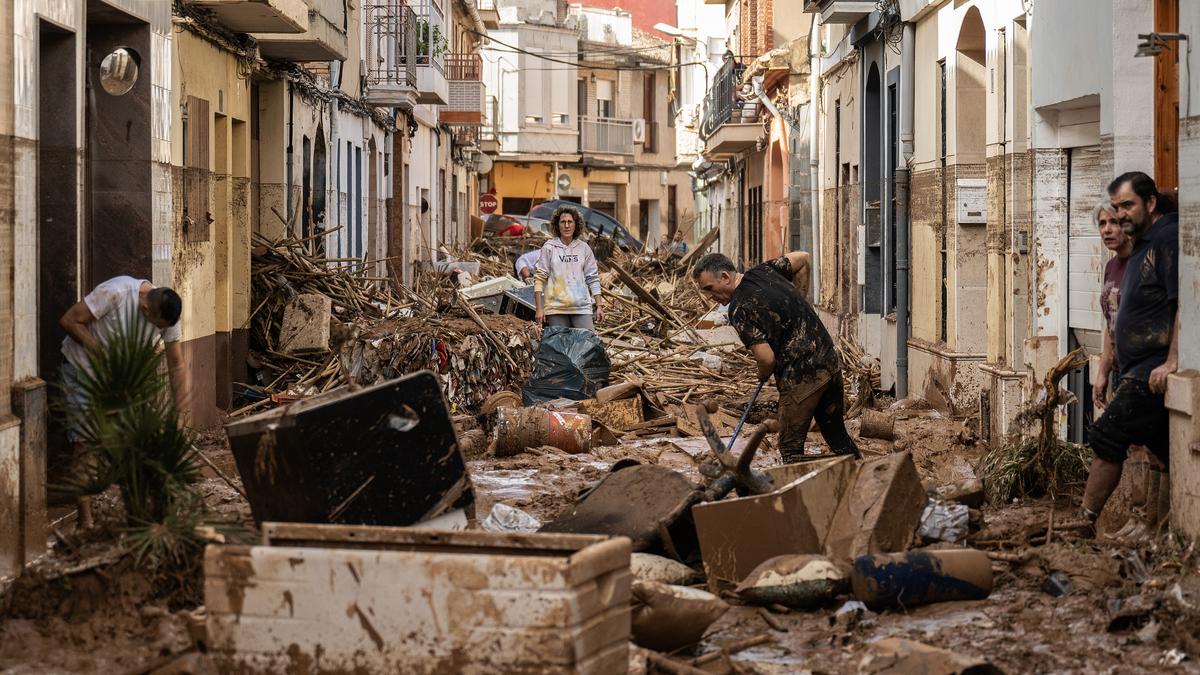Residents clean up a mud-and-debris-covered street after flooding hits large parts of the country on October 31, 2024 in the Paiporta municipality of Valencia, Spain.
| Photo Credit: Getty Images
The story so far: A global mean temperature rise of 2ºC is enshrined in the Paris Agreement as a safe level of global warming by 2100 with respect to the pre-industrial baseline. This threshold was reduced further to 1.5ºC due to the demand from the Alliance of Small Island and Developing States. The climate community has since been trying to quantify climate change and its consequences relative to these warming levels. Unfortunately, the models scientists use for climate projections aren’t perfect, which affects the uncertainties in global mean temperature rise estimates. To make predictions for years far beyond 2050, the models need to know the greenhouse gas emissions at the time. Modellers create these figures by imagining energy sources of the future, population growth, and climate actions and policies by then. However, it is anything but easy to simulate societies of the distant future. Thus, projections of global warming in the distant future depend heavily on uncertainties inherent to these speculative scenarios.
Is global mean warming important?
After 2023 and 2024 turned out to be record warm years, the spectre of crossing the 1.5ºC threshold looms large. However, the 2ºC warming threshold emerged from a rather arbitrary assumption rooted in the work of economics Nobel laureate William Nordhaus in the 1970s.
There has been much debate since as to what this figure represents in real terms, because the two warming levels — 1.5ºC and 2ºC — aren’t particularly special in climate science. In fact, there are uncertainties about the magnitude and/or duration of warming overshoot required for it to be catastrophic. The onslaught of climate-related disasters also makes it clear that any additional warming should be avoided. The exact amount of warming, whether 1.5ºC, 1.75ºC or 2ºC, hardly matters for disaster management and adaptations required today.
Did the world really cross 1.5ºC?
Global temperature estimates are prepared by blending observations and models. Also, multiple groups produce multiple models, which produce multiple estimates — and they are not alike. Two such models of late have claimed the world exceeded 1.5ºC of warming in late 2024 whereas one has estimated the world didn’t. Be that as it may, the question remains as to whether 2025 will continue to warm or if the rate of warming will drop. Rapid warming events in the past suggest that the rate of warming after sudden jumps tends to decline after a few years. For example, 2024 started out warm following the record warmth of 2023 before the rate of warming dropped. The rate in 2025 has already fallen below that seen in 2024 for the same months. Considering the uncertainties in warming plus irreducible uncertainties in estimating today’s temperatures, it is confusing why global mean warming levels remain relevant.
Climate adaptation and resilience require large investments. We also need reliable local information to avoid maladapting. Thus, climate mitigation must continue, in fact even accelerate while global mean warming is a distraction we can do without. But with the back-pedalling on climate action in some countries, short-and medium-term predictions, from days to a decade or two, are most urgent now, especially at the hyperlocal scale.
What about climate disasters?
Climate disasters like heatwaves, floods, and droughts are becoming more protracted, frequent, and intense. Insurance losses, number of lives, and number of livelihoods lost worldwide are rising year on year. These disasters are a reminder that unless researchers can pinpoint which disaster is likely to occur where and with sufficient actionable lead time — for example, a few days to few weeks for most extreme events — focusing on global mean warming can be wasteful, if not misguided.
Early-warning systems and disaster management are becoming better overall and global plans under the UN, such as Early Warnings for All, promise to ensure poorer countries are not left out. If we are to manage day-to-day crises better even as the risks of climate hazards increase, we also need predictions at the decadal timescale to allow countries to plan ahead for adaptation and resilience. This in turn demands that we focus on tracking disasters, preparedness, management and recovery.
The earth’s tropics are a hotspot of climate change’s consequences since they are warmer to begin with. So catastrophic floods outside the tropics, such as those in Valencia in 2024, are a stark reminder that good early warnings are worthless unless they are actionable up to the last mile. It has become common in the wake of disasters for some research groups to claim it was caused by global warming. However, we need to focus on more important questions: whether a given forecast was accurate and whether all disaster management agencies on the ground received it in time. If a forecast fails, they need to be recorded and documented as such; if a forecast was accurate but the government failed to prepare for it in time, the points of failure must be quickly identified and corrected.
This acknowledges that climate risk and uncertainties are never zero, that risks are not predestined, and that we have agency in mitigating them.
Raghu Murtugudde is retired professor, IIT Bombay, and emeritus professor, University of Maryland.
Published – June 05, 2025 08:30 am IST
